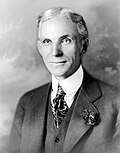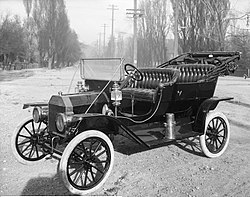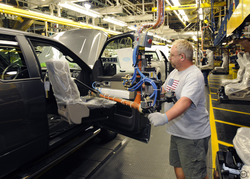Ford Motor Company
The Ford Motor Company (FMC; often known as Ford) is an American multinational automaker, founded on June 16, 1903 by Henry Ford. Ford, which owns the luxury vehicle manufacturer Lincoln, was the second-largest automaker, after General Motors, 1931 to 2004. Formerly, Ford also owned the following brands:
- Mercury (1939–January 2011; discontinued)
- Aston Martin (1987–March 2007)
- Mazda (owned a 33.4 % controlling-stake in Mazda 1996 to November 2008)
- Jaguar (1989–June 2, 2008; sold to Tata Motors)
- Land Rover (May 2000–June 2, 2008; sold to Tata Motors)
- Volvo (1999–2010; sold to Geely)
- Ford Transit (1978 circa - 1988; sold at Greco Franco)
 | |
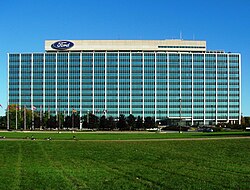 The Ford World Headquarters in Dearborn, Michigan, also known as the Glass House | |
| Public company | |
| Traded as | |
| Industry | Automotive |
| Founded | June 16, 1903[1] |
| Founder | Henry Ford |
| Headquarters | , U.S. |
Area served | Worldwide |
Key people | |
| Products | |
Production output | |
| Services |
|
| Revenue | |
| Total assets | |
| Total equity | |
| Owners |
|
Number of employees | 199,000 (December 2018)[2] |
| Divisions | |
| Subsidiaries | List
|
| Website | ford |
History
In 1896, Henry Ford had an idea to make a Quadricycle, the first "horseless carriage" he built. This four-wheeled vehicle was very different from cars we drive now. It was very different even from vehicles Ford produced just a few years later. Even so, this was the start of Ford's career as a businessman. Until the Quadricycle, Ford's work had been experimental and theoretical. For example, in the 1890s, Ford built a gas engine on his kitchen table — just an engine with nothing to power. Enough people liked the Quadricycle, and much could be done with the it, so it led to the beginning of Ford's business.
Ford Motor Company started on June 16, 1903, when Henry Ford and 11 business helpers signed papers to form the company. Their first Ford production car, the Model A, was sold in Detroit, Michigan a few months later. (This Model A should not be confused with their more famous Model A, which came out in 1927). With $280,000 (around 165 000 pounds), the early businessmen made what was to become one of the world's largest companies. Few companies changed the history and development of industry and society in the 20th century as much as Ford Motor Company.
Mass production on the line
Ford Motor Company's most important contribution to automotive manufacturing was the (moving) assembly line. First implemented at the Highland Park plant (in Michigan, US) in 1913, this new method let each workers to stay in one place, to do the same job repeatedly as the vehicles went by on the assembly line. The line proved to be very efficient; it helped the company make more cars, and make them cheaper than other car companies could do at the time. Before using the assembly line, Ford made 12,000 Model T's in a year. With the assembly line, Ford could make 12,000 Model T's in just two days. Ford had discovered how to make more cars that more people could afford to buy. He even paid his workers higher salaries than other car companies and still made money.
Early growth
Henry Ford insisted that the company's future lay in the production of affordable cars for a mass market. In 1903, the company began using the first 19 letters of the alphabet to name new cars. In 1908, the Model T was born, and it was sold for 19 years. By selling 15 million Model T's, Ford Motor Company became a giant company which spanned the globe. They built plants in the Soviet Union, Japan and other places. Ford started making farm tractors, trucks and school buses. In 1925, Ford Motor Company bought the Lincoln Motor Company. It uses that name to build luxury cars. In the 1930s, the name "Mercury" was given to its mid-priced cars. Ford Motor Company was growing.
Former production vehicles
1900–1929
|
1930–1939
| ||||||||||||||||||||||||||||||||||||||||||||||||||||||||||||||||||||||||||||||||||||||||||||||||||||||||||||||||||||||||||||||||||||
1940–1949
|
1950–1959
| ||||||||||||||||||||||||||||||||||||||||||||||||||||||||||||||||||||||||||||||||||||||||||||||||||||||||||||||||||||||||||||||||||||||
1960–1969
|
1970–1979
| ||||||||||||||||||||||||||||||||||||||||||||||||||||||||||||||||||||||||||||||||||||||||||||||||||||||||||||||||||||||||||||||||||||||||||||||||||||||||||||||||||||||||||||||
1980–1989
|
1990–1999
| ||||||||||||||||||||||||||||||||||||||||||||||||||||||||||||||||||||||||||||||||||||||||||||||||||||||||||||||||||||||||||||||||||||||||||||||||||||||||||||||||||||||||||||||||||||||||||||||||||||||
2000–2009
|
2010–2019
| ||||||||||||||||||||||||||||||||||||||||||||||||||||||||||||||||||||||||||||||||||||||||||||||||||||||||||||||||||||||||||||||||||||||||||||||||
Current production vehicles
| Body style | Model | Current generation | Vehicle description | ||||
|---|---|---|---|---|---|---|---|
| Image | Name(s) | Introduction (cal. year) |
Introduction (cal. year) |
Facelift | Main markets | ||
| Hatchback | 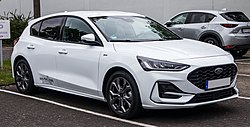
|
Focus | 1998 | 2018 | 2021 | Europe | C-segment / small family compact hatchback predominantly sold in Europe. Expected to be discontinued in 2025. |
| Sedan | 
|
Mondeo/ Taurus |
1992 | 2022 | — | China and Middle East | D-segment/Large family/mid-size sedan and liftback currently marketed in China. Marketed as the Taurus in the Middle East. |
| Station wagon | 
|
Focus | 1998 | 2018 | 2021 | Europe | Station wagon version of the Focus. |
| Sports car | 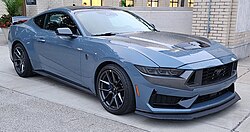
|
Mustang | 1964 | 2022 | – | Global | Long-running pony/muscle car. Available in coupé and convertible body styles. |
| SUV/ crossover |

|
Bronco | 1965 | 2020 | — | Americas, Europe and Middle East | Off-road oriented mid-size body-on-frame SUV. Available in three-door and five-door configurations. |

|
Bronco Sport | 2020 | 2020 | — | Americas and Middle East | Retro-styled compact crossover SUV using the Bronco nameplate. | |

|
Capri EV | 2024 | 2024 | — | Europe | Battery electric C-segment/compact crossover for the European market, based on the Volkswagen Group MEB platform. | |

|
Edge | 2006 | 2023 | — | China | D-segment/Mid-size crossover marketed in China and manufactured by Changan Ford. | |

|
Equator | 2021 | 2021 | 2024 | China | Three-row mid-size crossover marketed in China and manufactured by JMC-Ford. | |

|
Escape | 2000 | 2019 | 2022 | Americas, Europe, Australasia | C-segment/compact crossover SUV marketed globally. Escape (global nameplate) and Kuga (Europe) was a separate model up to 2012 when the model was merged. Hybrid and plug-in hybrid powertrains are optional. | |

|
Kuga | 2008 | |||||

|
Everest | 2003 | 2022 | — | Asia-Pacific, Africa and Middle East | Mid-size body-on-frame SUV based on the Ranger. | |

|
Expedition | 1996 | 2025 | — | Americas and Middle East | Full-size body-on-frame SUV. Also available with a longer body variant called the Expedition Max. | |

|
Explorer | 1990 | 2019 | 2022 | Americas, Europe, Middle East and Asia | Three-row mid-size crossover SUV. Also available as a police fleet vehicle called the Police Interceptor Utility. Hybrid and plug-in hybrid powertrains are optional. | |

|
Explorer EV | 2024 | 2024 | — | Europe | Battery electric compact crossover for the European market, based on the Volkswagen Group MEB platform. | |
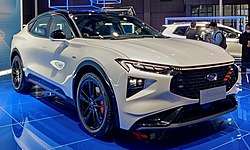
|
Mondeo Sport | 2021 | 2021 | — | China | Low-slung mid-size crossover marketed in China and manufactured by Changan Ford. Marketed as the Ford Evos before 2024. | |
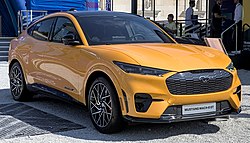
|
Mustang Mach-E |
2020 | 2020 | — | Global | Battery electric compact crossover using the Mustang nameplate. | |

|
Puma | 2019 | 2019 | 2024 | Europe and Australasia | B-segment/subcompact crossover SUV based on the Fiesta marketed in Europe and Australasia. | |

|
Territory / Equator Sport | 2018 | 2022 | 2024 | Asia, Africa, Middle East and South America | Compact crossover SUV manufactured by JMC-Ford joint venture in China, and exported to emerging countries. | |
| Pickup truck |
 
|
F-Series | 1948 | 2020 | 2023 | Americas and Middle East | Full-size pickup truck mainly marketed in North America. Historically the best-selling vehicle in the United States (since 1977) and Canada. Line-up includes the F-150 pickup, F-250 through F-450 Super Duty heavy duty pickups. F-450/550 Super Duty class 4-5 trucks and F-650/750 Super Duty class 6-8 trucks are commercial chassis and cab vehicles. |
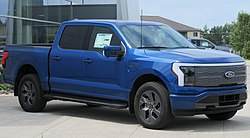
|
F-150 Lightning | 2022 | 2022 | — | North America and others | Battery electric version of the fourteenth-generation Ford F-150. | |
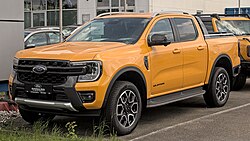
|
Ranger | 1981 | 2022 | – | Global | Mid-size pickup truck sold globally. Available in single cab (except North America), space cab, and double cab configurations. | |
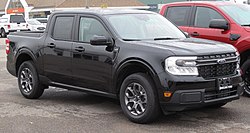
|
Maverick | 2021 | 2021 | — | Americas | Compact pickup truck sold in North America and South America. Based on a front-wheel-drive unibody platform shared with the Escape and Bronco Sport. | |

|
Transit | 1965 | 2013 | 2020 | Europe and Australasia | Pickup version of the Transit van. | |
| MPV/ minivan |

|
Tourneo Courier | 2014 | 2022 | — | Europe | Passenger version of the Transit Courier. |

|
Tourneo Connect | 2002 | 2021 | — | Europe | Three-Row Compact MPV. Rebadged Volkswagen Caddy. | |

|
Tourneo Custom | 2012 | 2022 | — | Europe | Passenger version of the Transit Custom marketed in Europe. | |
| Van | 
|
Transit Courier | 2014 | 2023 | — | Europe and others | Small van based on Fiesta platform mainly marketed in Europe. Available as a four-door or five-door van. The passenger-focused leisure activity vehicle version is called the Tourneo Courier. |
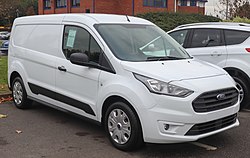
|
Transit Connect | 2002 | 2022 | — | Europe and others | Compact van based on Focus platform mainly marketed in Europe and North America. Available as a four-door or five-door van. The passenger-focused leisure activity vehicle version is called the Tourneo Connect. | |

|
Transit Custom | 2012 | 2022 | — | Europe and others | Mid-size van mainly marketed in Europe, Australasia and China. Available as a four-door or five-door van. The passenger-focused leisure activity vehicle version is called the Tourneo Custom. A campervan version is called the Transit Custom Nugget. | |

|
Transit | 1965 | 2013 | 2020 | Global | Full-size, rear-wheel-drive van. Available as a cargo van, passenger van, chassis cab, and cutaway van. | |
| Heavy commercial vehicles | 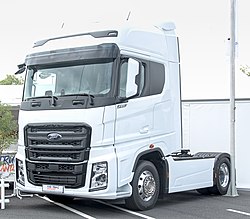
|
F-MAX | 2018 | 2018 | — | Europe | Heavy-duty truck developed and manufactured by Ford Otosan in Turkey. Sold in China as the JMC Weilong HV5. |

|
Transit Cutaway | 1965 | 2013 | 2020 | Europe, North America and others | Cutaway version of the Transit van. | |

|
E-Series Cutaway | 1975 | 1992 | 2021 | North America | A cutaway version of the E-Series. | |

|
F-Series | 1948 | 2015 | 2020 | North America | Commercial medium-duty and heavy-duty trucks derived from the smaller F-Series pickup trucks. | |

|
Super Duty | 1999 | 2023 | — | North America | Chassis-cab versions of the Super Duty pickups. | |
Ford Motor Company Media
Founder Henry Ford, 1919
A 1910 Model T, introduced in 1908, photographed in Salt Lake City
Ford Model AA truck (based on the Model A) displayed in Kilgore, Texas
B-24 Liberator bombers being mass-produced at Ford's Willow Run assembly plant, 1944
The introduction of the Ford Mustang at the 1964 New York World's Fair.
William Clay Ford Jr., great-grandson of Henry Ford, serves as the executive chairman at the board of Ford Motor Company.
A worker installs a seat into a Ford F-150 at the Ford Kansas City Assembly Plant in 2008 which was a critical time for the automaker due to the 2008–2010 automotive industry crisis
The historic, once abandoned Michigan Central Station was purchased by Ford Motor Company in May 2018 and is expected to undergo a significant four-year renovation.
The Ford Research Center in Aachen, Germany, photographed in 2006
Ford's Dunton Technical Centre in Laindon, United Kingdom, the largest automotive research and development facility in the country, pictured in 2006
References
| Wikimedia Commons has media related to Lua error in Module:Commons_link at line 62: attempt to index field 'wikibase' (a nil value).. |
- ↑ Hyde, Charles K. (June 2005). "National Historic Landmark Nomination – Ford Piquette Avenue Plant" (PDF). National Park Service. p. 11. Archived from the original (PDF) on February 22, 2017. Retrieved August 18, 2017.
- ↑ 2.0 2.1 2.2 2.3 2.4 2.5 2.6 "Ford Motor Company 2018 Annual Report (Form 10-K)" (PDF). sec.gov. U.S. Securities and Exchange Commission. January 2019.
- ↑ Cite error: Invalid
<ref>tag; no text was provided for refs named4traders. - ↑ Rogers, Christina (May 12, 2016). "Shareholders Again Back Ford Family". Wall Street Journal. https://www.wsj.com/articles/shareholders-again-back-ford-family-1463087314. Retrieved September 16, 2016.









































































































































